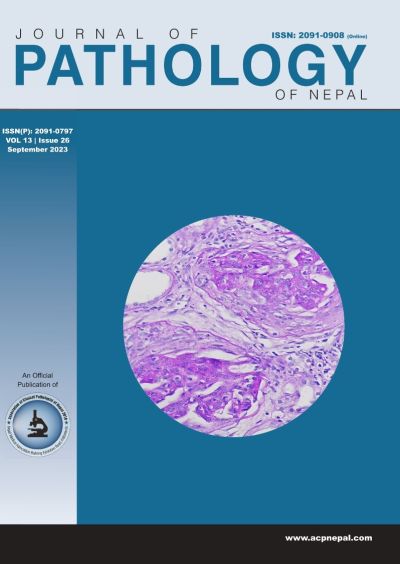A study of eosinophil count in oesophageal and gastric mucosal biopsies at a tertiary care centre
DOI:
https://doi.org/10.3126/jpn.v13i2.46929Keywords:
Eosinophils, Oesophageal, gastric biopsy, Helicobacter pyloriAbstract
Background: Eosinophils are inflammatory cells that can infiltrate several organs playing a major role in causing tissue damage and organ dysfunction. This study was conducted to establish the baseline eosinophil count in normal states and to correlate mucosal eosinophil count with abnormalities of the oesophagus and stomach.
Materials and methods: A retrospective observational study was conducted at the surgical pathology department of a tertiary care hospital in Mumbai. A total of 124 biopsies were studied. Oesophageal and stomach biopsies with some pathology including oesophagitis, gastritis, ulcer, nonspecific inflammation, etc, were considered abnormal.
Results: Out of 124 biopsies, 36 (29.03%) were normal, while 88 (70.97%) were abnormal. Eosinophilic gastrointestinal disease had male predilection. In abnormal oesophageal biopsies, 16 (88.9%) of 18 oesophageal biopsies had an eosinophil count in the 0-5 eos/HPF band, whereas 50 (71.4%) of 70 abnormal stomach biopsies had eosinophils in the 0-5 eos/HPF band. The eosinophil count reported was 24/HPF in eosinophilic oesophagitis.
Conclusions: Almost all normal oesophageal biopsies (90.9%) and stomach biopsies (100%) showed eosinophil count as 0 eos/HPF and <10/HPF respectively. So if one finds eosinophils in a biopsy sample, one needs to look for other specific pathology.
Downloads
Downloads
Published
How to Cite
Issue
Section
License
Copyright (c) 2023 The Author(s)

This work is licensed under a Creative Commons Attribution 4.0 International License.
This license enables reusers to distribute, remix, adapt, and build upon the material in any medium or format, so long as attribution is given to the creator. The license allows for commercial use.




